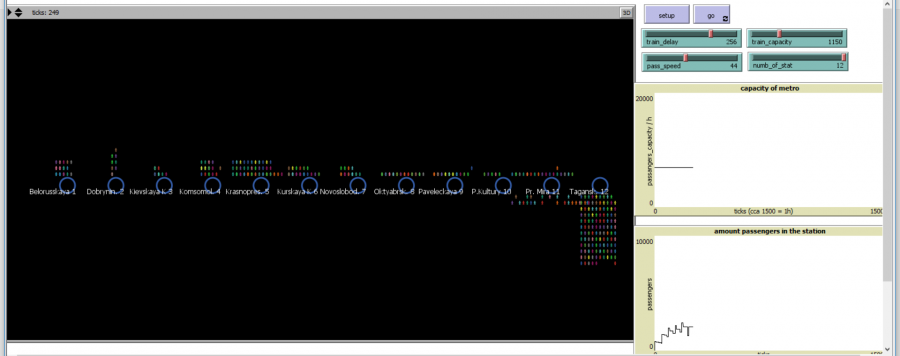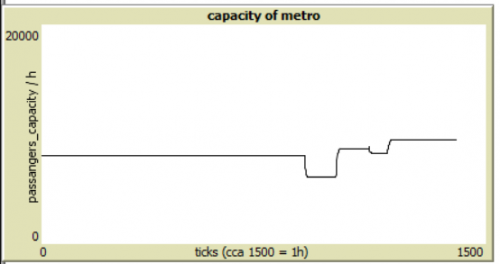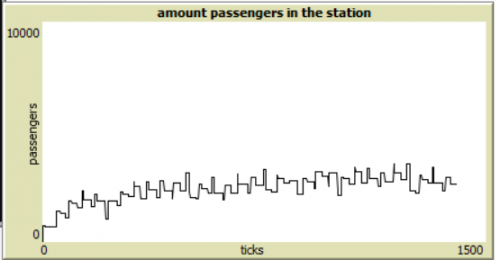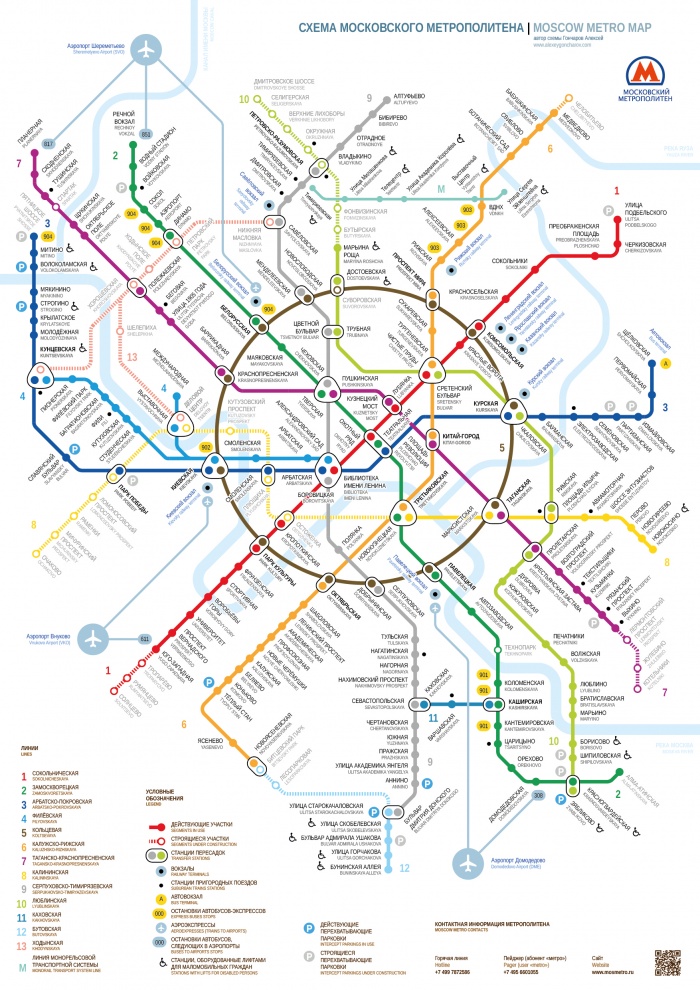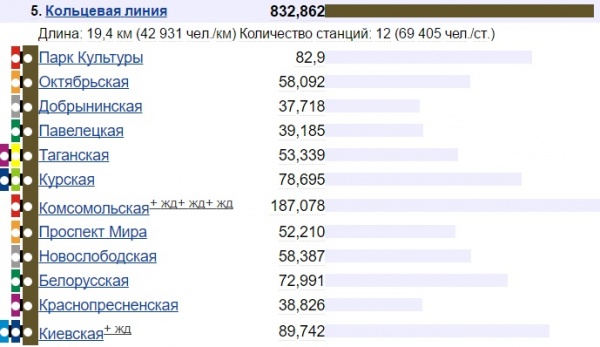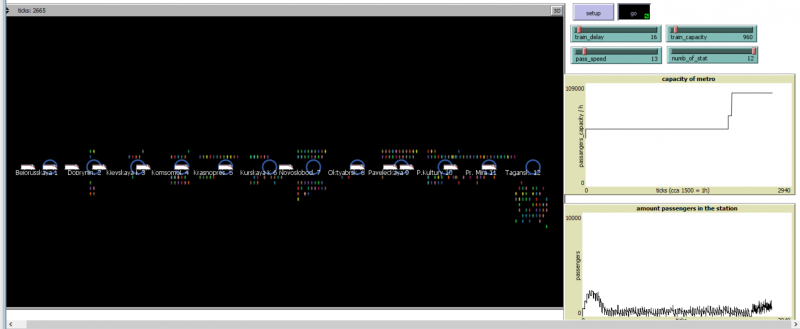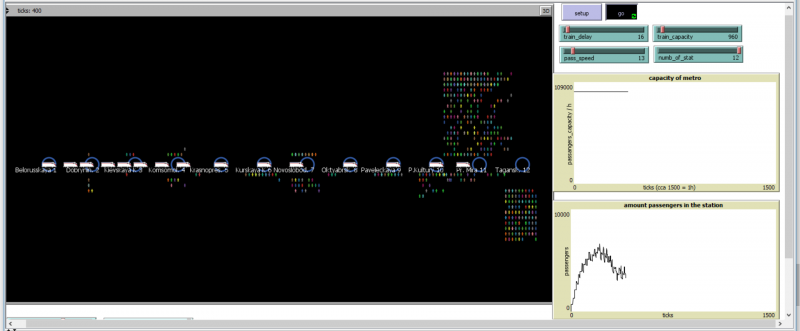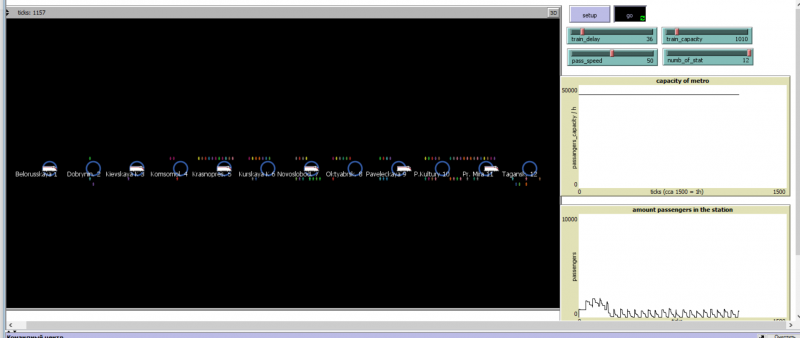Optimal schedule of Moscow metro
Project name: Optimal schedule of Moscow metro
Class: 4IT496 Simulation of Systems (WS 2016/2017)
Author: Bc. Kateryna Ushanova
Model type: Agent-based simulation
Software used: NetLogo
Contents
Introduction
The simulation will show situation in Moscow metro in different parts of the day (peak hour and off-peak hour). In this simulation i will find optimal time of train´s delay in concrete line in Moscow subway. The input data have been taken from [1] and [2]
Problem definition
Nowadays subway is one of the most used types of transport. In order to increase productivity and prevent some traffic jams in metro this simulation was created. In this simulation you can observe and control by yourself situations in different parts of the day:
- peak hour - which commonly takes place from 7 a.m. till 10 a.m. and from 4 p.m. till 7 p.m.
- off-peak hour - rest of the day
Method
Environment: NetLogo 5.3.1
Goals of the simulation
- To figure out in which situations traffic jams occurs
- Find the optimal ratio between number of travellers and time of delay
- To find out how to minimized amount of waiting people at stations
Description of the simulation
Interface
The grafical user interface of the model
Key parameters:
train_delay - delay time of each train. Time interval between trains
train_capacity - capacity of one train. One train contains 10 real people
rank_xy - number of passengers in the station (it depends on part of the day (e.g. peak hour) - Different parameter for each station
numb_of_stat - number of stations
pass_speed - level of passenger's speed
Buttons
SETUP button creates the metro map and passengers.
GO - start the simulation.´
Sliders
TRAIN_DELAY
TRAIN_CAPACITY
NUMB_OF_STAT
PASS_SPEED
RANK_XY
Graphs
Capacity of metro
Graph shows capacity of metro during one hour. Progress in this graph depends on many parameters like train capacity and train delay.
Amount passengers in the station
This graph shows amount of passengers who are waiting the train.
How does the simulation work
In this simulation I used different parameters. Some of this parameters have min and max value. Station_id in the parameter Passenger indicates in which station this passenger will go out. Outgoing passengers show under the platform and then disappear. If the station is overcrowded people will turn red and another passengers cannot go to this platform. Parameter station indicated as station_min and station_max that means possible amount of people which can be in this station at one moment. Tne number of people is a random number. Final station has set 0 because there cannot be any departures. Due to the large number of people (most probably in peak-hour} the train can delay. It is additional 0,5 tick of waiting for train departures. In the station can be only one train at the moment. So in case of delay the next train have to wait in tunnel until the station will be free. To observe situation I'm metro more deeply I also created parameter Rank_(number of station) for each station which user can control by yourself. This parameter indicates probability that passenger will exit the train in this station.
Moscow metro is very big, has 13 lines and 203 stations.
In this work I choose Kolcevaya line which has 12 stations. Length of the line is 19,4 km ( on the picture above it's brown line number 5 )
In the source [3] I found average daily passenger number in the line Kolcevaya in total (69405 person) and in each stations. In the picture it is in Russian language.
Results
The goal of the simulation is to observe Moscow metro and one of the line - Kolcevaya. This simulation was created as one-way traffic. Based on the data of average passenger number each station has his own ratio.
Simulation is observed in two parts - peak-hour and off-peak
Peak-hour
Analyzing the simulation I figured out that if the train delay is 30 or less it leads to traffic jam and train have to wait in tunnel until the station will be free. Capacity of metro is near 98000 person per hour. The optimal delay between trains is 45-60 sec.
Some of stations are overcrowded
Off-peak
In rest of the day when it is not peak-hour people don't hurry up. Parameter which shows level of passenger speed I reduced and train capacity in this period is more. So in the off-peak part of the day when delay between trains is 26 - it doesn't lead to traffic jams and stations are not overcrowded.
The optimal delay between trains is 26-50 sec. Capacity of metro is near 50000 person per hour.
Conclusion
"Playing" with different parameters in this simulation I can say that because of a large number of people in Moscow metro there is need of train frequancies. I found the optimal ratio in peak-hour and off-peak. Comparing with timetable of Moscow metro the numbers are quite similar but in real life we can see overcrowded stations in peak-hour. But in my opinion is not a problem of transport company but of extralarge number of people and this stations are not adapted.
Code
External links
Moscow subway http://dic.academic.ru/dic.nsf/ruwiki/205954
Passenger traffic on the lines in Moscow metro http://www.prgp.ru/articles/obzory-issledovaniy/metro_traffic//
